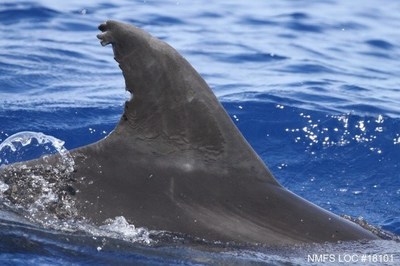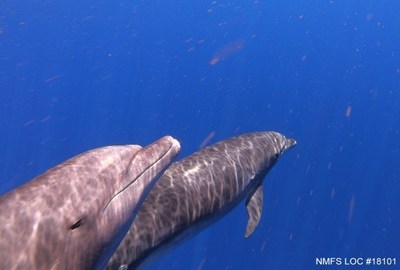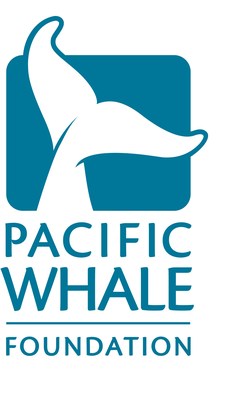Subjects: NPT, SVY, ANW
Fisheries Interactions More Threatening to Maui Nui Dolphins than Previously Thought: Pacific Whale Foundation Researchers Discover New Evidence
MA'ALAEA, Hawaii, Sept. 20, 2021 /PRNewswire/ -- Researchers at Pacific Whale Foundation (PWF), a nonprofit organization protecting the ocean through science and advocacy since 1980, dove deep below the surface in a new study that could revolutionize how researchers evaluate the impact of fisheries interactions on dolphin populations. Using dorsal fin, mouth line and underwater body imagery, the latter a first of its kind for this type of study, researchers found that fisheries interactions on Maui Nui dolphins may be more pervasive than initially thought.
Principal investigator Jens Currie, PWF's Chief Scientist and co-author oversaw the recently published paper, External Scarring as an Indicator of Fisheries Interactions with Bottlenose (Tursiops truncatus) and Pantropical Spotted (Stenella attenuata) Dolphins in Maui Nui, Hawai'i which used PWF's long-term historic data on bottlenose and spotted dolphins collected over a 24-year period from 1996-2020. A recent paper citing an apparent decline in bottlenose dolphin population in Maui Nui highlights the importance of PWF's study in exploring the potential impacts of fisheries interaction to these dolphins.
Abigail Machernis, PWF Research Biologist and lead author of the paper, examined data collected in the Maui Nui region of Hawai'i, which consists of the islands of Maui, Moloka'i, Lana'i and Kaho'olawe and found 27% of 255 identified bottlenose dolphins and 13% of 374 identified spotted dolphins displayed one or more fishery gear-related scars. Every image in the nonprofit's extensive photo-ID catalog, was reviewed to identify dolphins with scars on dorsal fins, mouthlines and bodies of dolphins that indicate past interactions with fisheries and fishing gear. The objectives of PWF's research were (1) to determine the number of bottlenose and spotted dolphins that showed evidence of a fisheries interaction in Maui Nui; and (2) to determine if underwater body images, in addition to the traditionally used dorsal fin and mouthline images, increased detection rates of evidence of fisheries interactions.
Building on established methodology, focused primarily on dorsal fin analysis, researchers used underwater body images to gain a new perspective for assessing fisheries interactions. The inclusion of underwater photo analysis was a game changer, according to Machernis. "Most research literature that examines fisheries interactions look primarily at dorsal fins and we wanted to use all the data we have collected to examine as much of the dolphins' body as possible for evidence of fishing-gear related scars."
The study's innovative approach involves combining individual assessments of dolphins' dorsal fins, mouthlines and bodies into a single assessment and found the inclusion of underwater imagery increased scar detection rates by 51% for bottlenose dolphins and 40% for spotted dolphins. Using past research on fisheries interactions coupled with forward-thinking research methods, the study is the first to present a standardized approach for using photos of dorsal fins, mouthlines, and underwater body footage into the assessment of fisheries interactions.
"Without documenting real-time interactions or observing physical gear on an animal's body, photo analysis is the best available proxy for quantifying fisheries interactions," notes Currie. "There is still more research to be done and we want to make sure we have all the information needed to determine if there is a conservation concern and then work with fishers on a solution if warranted."
Worldwide, interactions with fisheries have been identified as one of the leading conservation concerns for cetaceans resulting in lethal or non-lethal consequences. The full extent is hard to assess as most entanglements are never observed, but research noted by the International Whaling Commission (IWC) suggests that over 300,000 whales and dolphins die annually due to entanglement in marine debris. This can have a devastating, long-term conservation impact on those populations that are already threatened, in some cases critically.
Past and ongoing research confirms that direct interactions between cetaceans and fishing gear typically transpire in one of two ways: (1) animals unintentionally swim into gear becoming entangled or entrapped or (2) animals deliberately remove fish captured in gear, a behavior known as depredating, and become hooked and/or entangled as a result. Some fishing gear interactions can result in serious injury or mortality from entanglement or ingestion of gear.
These types of interactions occur globally and are likely to increase due to the potential for continued human encroachment on cetacean habitats. Thus, the paper asserts, population-level impacts of fisheries on cetaceans are of great concern and there is a critical need to identify which species interact with which fisheries and the location(s) these interactions occur so researchers can work with fishers to find sustainable solutions.
In short, Machernis concludes that these findings suggest that fisheries interactions are more widespread than we previously thought, and this can have implications on how we manage these near shore island-associated populations. In addition to informing management and conservation actions, the study and paper support outreach efforts targeting recreational and commercial fishers that provide education on best fishing practices when dolphins are present.
"We highly recommend researchers interested in examining the threat of fisheries interactions to dolphins make a concerted effort in the field to collect above-water mouth line and body shots, in addition to underwater footage," Machernis advises, emphasizing the value of images such as those studied in providing a more accurate analysis of scar detection rates.
PWF's scientific paper, External Scarring as an Indicator of Fisheries Interactions with Bottlenose (Tursiops truncatus) and Pantropical Spotted (Stenella attenuata) Dolphins in Maui Nui, Hawai'i authored by Abigail Machernis, Stephanie H. Stack, Grace L. Olson, Florence A. Sullivan and Jens Currie, is published in Aquatic Mammals and available for review. All Pacific Whale Foundation publications are freely available at PacificWhale.org/research/publications.
To learn more or make a contribution to support PWF's dolphin research, please visit PacificWhale.org/pacific-whale-foundation/.
About Pacific Whale Foundation
With a mission to protect the ocean through science and advocacy and to inspire environmental stewardship, Pacific Whale Foundation (PWF) conducts Research, Education and Conservation programs. Founded in 1980 as a 501(c)(3) nonprofit organization dedicated to saving the world's whales from extinction, PWF now solely owns social enterprise PacWhale Eco-Adventures, which offers fee-based programs and services to help support the nonprofit. Combined with memberships, donations, charitable grants and a remarkable group of dedicated volunteers, PWF now reaches more than 400,000 individuals each year through its Maui and Australia offices and research projects in Ecuador and Chile.
SOURCE Pacific Whale Foundation
These press releases may also interest you
|
News published on and distributed by:






